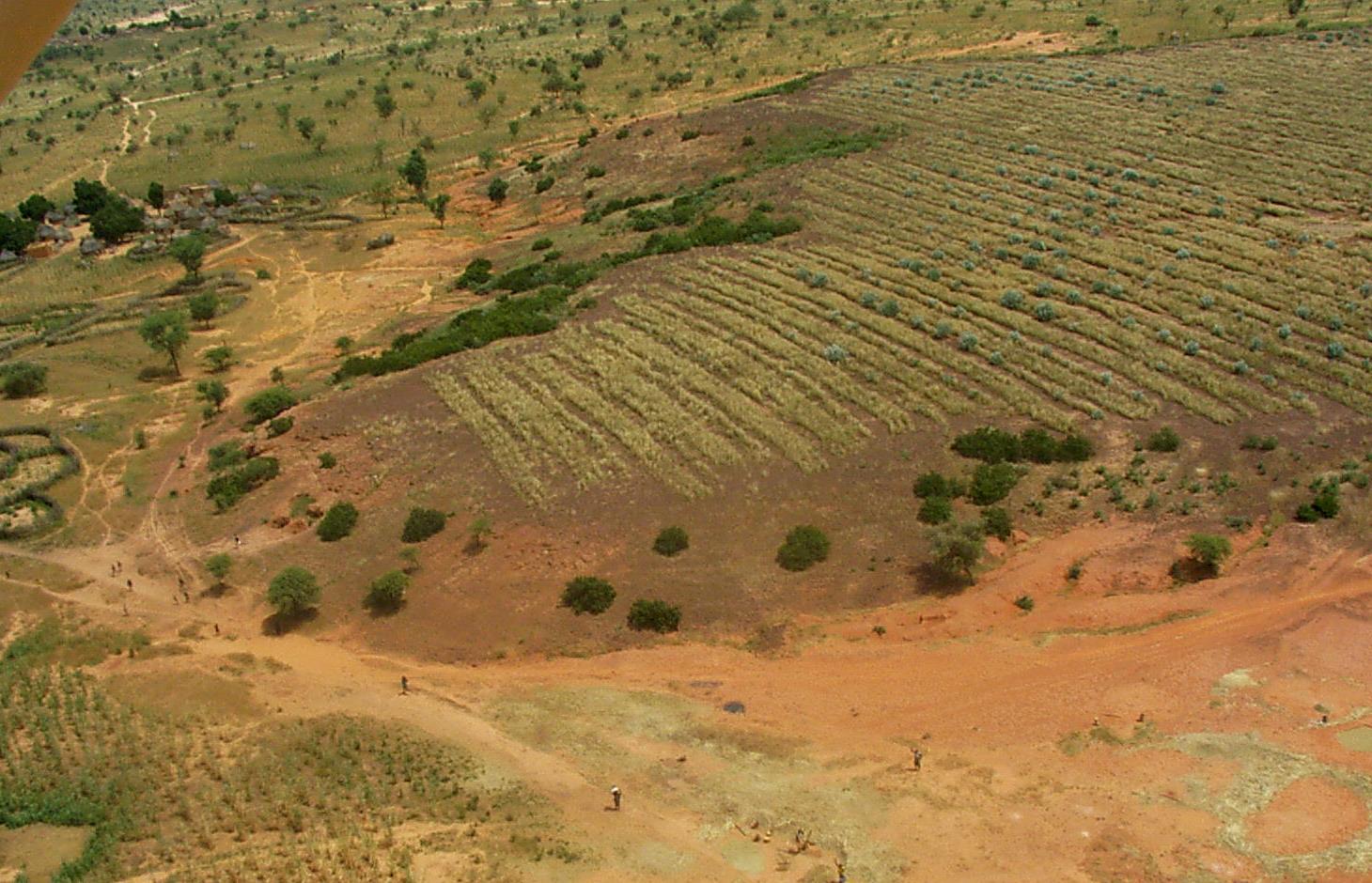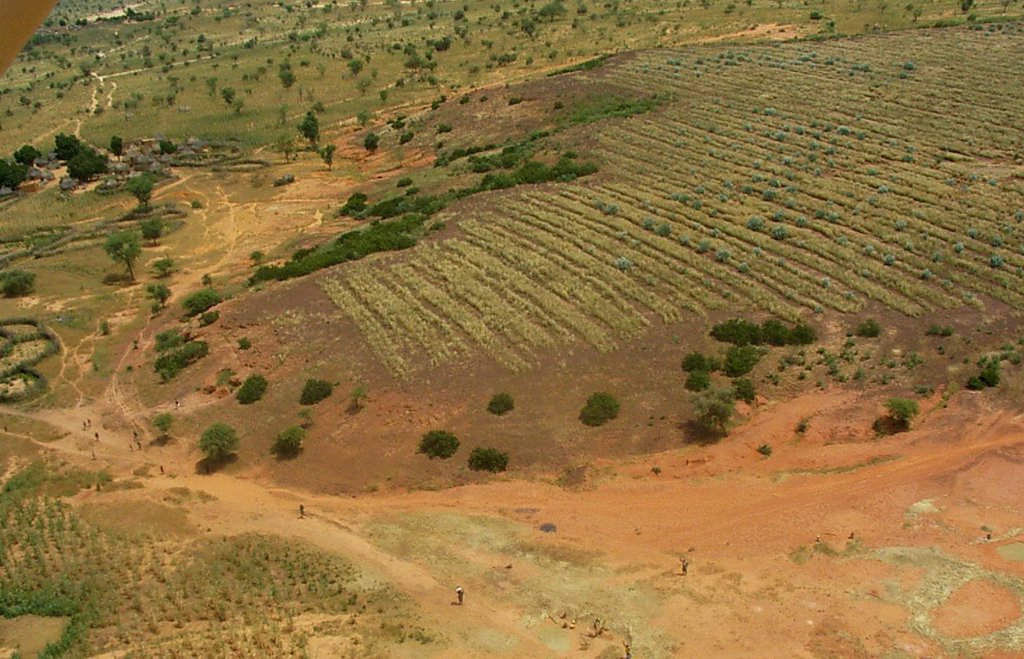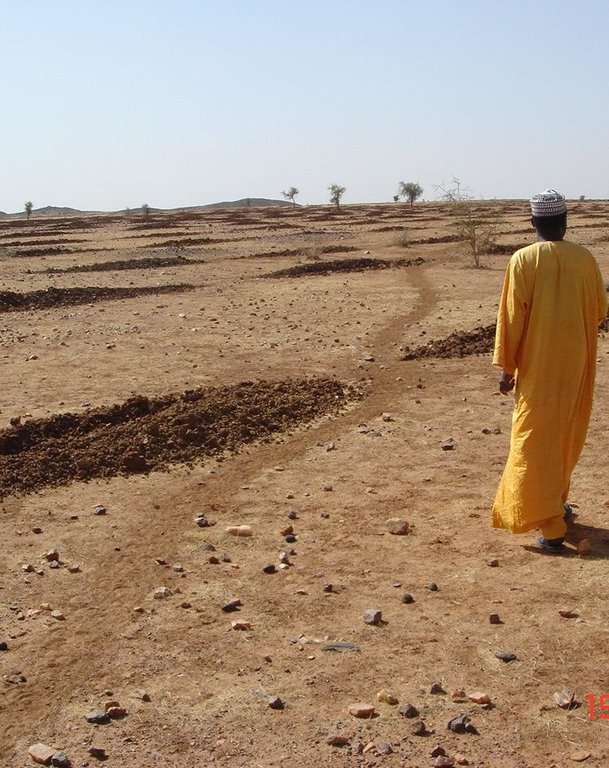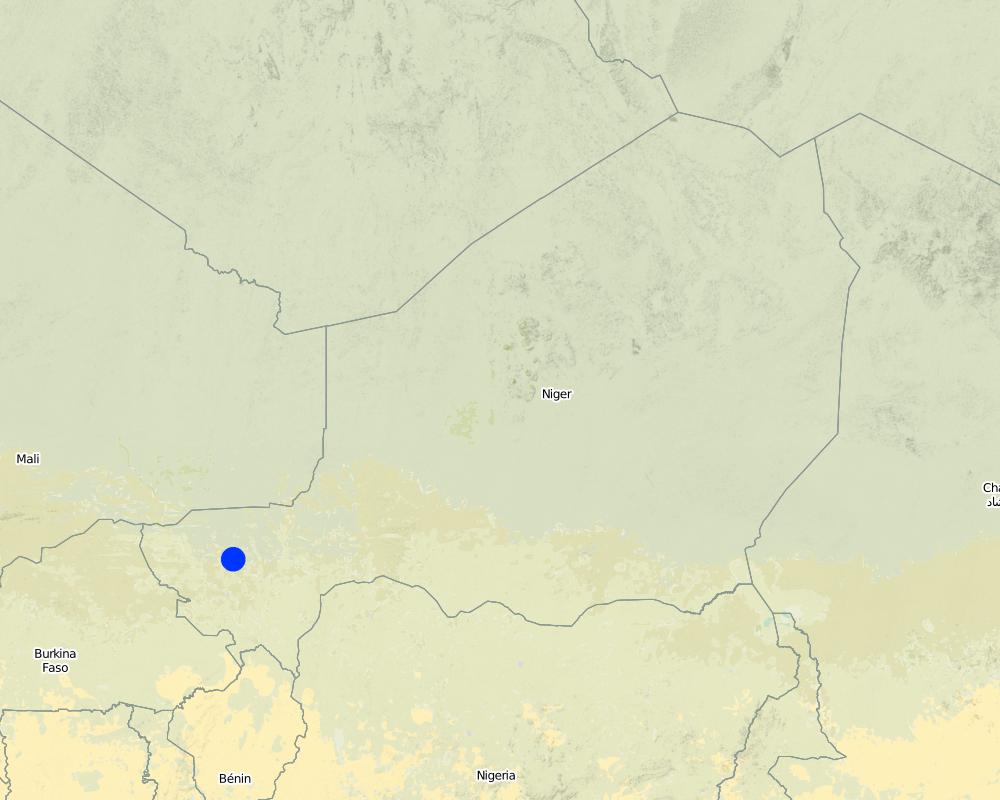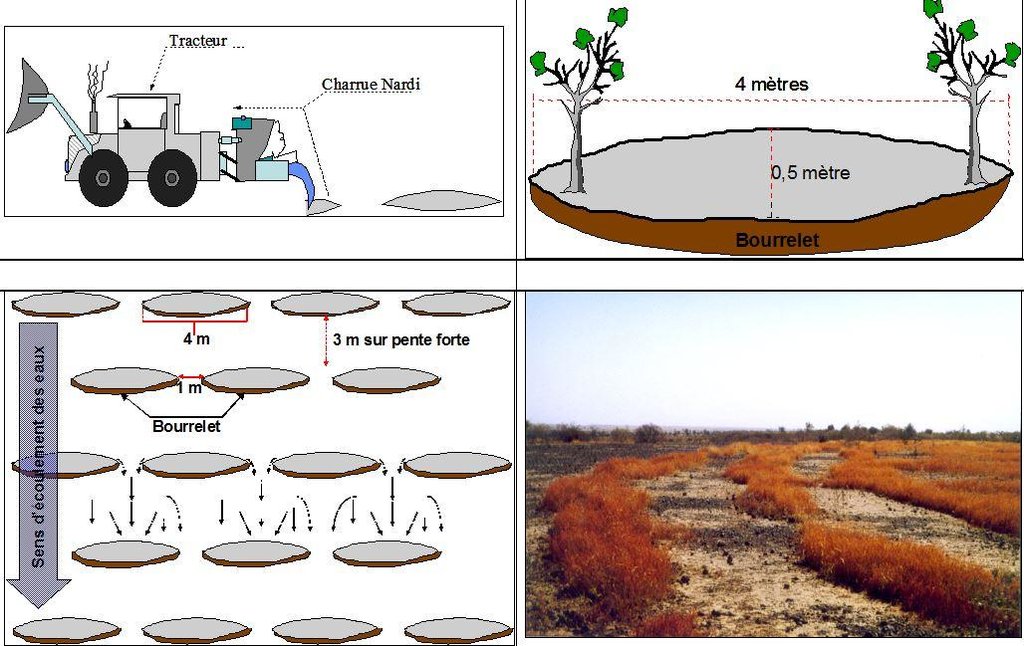Nardi/Vallerani trenches [Niger]
- Creation:
- Update:
- Compiler: Dieter Nill
- Editor: –
- Reviewers: Deborah Niggli, Alexandra Gavilano
Tranchées Nardi (French)
technologies_1613 - Niger
View sections
Expand all Collapse all1. General information
1.2 Contact details of resource persons and institutions involved in the assessment and documentation of the Technology
Name of project which facilitated the documentation/ evaluation of the Technology (if relevant)
Good Practices in Soil and Water Conservation - A contribution to adaptation and farmers ́ resilience towards climate change in the Sahel (GIZ)Name of the institution(s) which facilitated the documentation/ evaluation of the Technology (if relevant)
Deutsche Gesellschaft für Internationale Zusammenarbeit (GIZ) GmbH (GIZ) - Germany1.3 Conditions regarding the use of data documented through WOCAT
The compiler and key resource person(s) accept the conditions regarding the use of data documented through WOCAT:
Yes
1.4 Declaration on sustainability of the described Technology
Is the Technology described here problematic with regard to land degradation, so that it cannot be declared a sustainable land management technology?
No
2. Description of the SLM Technology
2.1 Short description of the Technology
Definition of the Technology:
Nardi/Vallerani trenches are microcatchments which are made using a special tractor-pulled plough to restore degraded and encrusted forests and rangelands
2.2 Detailed description of the Technology
Description:
Nardi/Vallerani trenches are microcatchments 4 m long and 0.5 m wide. They are made using a tractor-pulled plough specifically designed for this purpose. The Nardi plough cuts a furrow perpendicular to the slope, throwing up a ridge on the downhill side and thereby creating a barrier on that side of the furrow. The number of trenches varies according to the gradient of the terrain and the type of soil: the recommended number of microcatchments for flat or gently sloping terrain is between 250 and 400 per hectare, with the rows spaced 5 to 7 m apart; and for steeper slopes, the rows should be spaced 3 to 4 m apart, with a density of up to 600 microcatchments per hectare. In each Nardi/Vallerani microcatchment, two or three trees are planted or sown by direct seeding and then separated when they come up. Perennial grasses are sown a year later to allow the trees to become established first. The choice of species largely depends on the use to which the improved land is to be put and the priorities of the beneficiaries. It is recommended that the improved site be protected from grazing animals for at least three years to give the trees time to grow and the grass time to reproduce naturally, although the exact amount of time required will depend on the type of trees planted and how degraded the site is.
Nardi/Vallerani trenches are generally combined with scarification, which is carried out using a tractor-pulled scarifier. The strips between the trenches are scarified a year after they have been dug. These scarified strips are sown with perennial grasses at the same time as the trenches. The trees planted the year before are a year old, and the risk of the saplings being choked by the grass is minimal.
Runoff collects in the Vallerani microcatchments, improving the infiltration of water into the soil and the retention of water for the plants growing in them. They also serve to loosen the soil and improve the plants’ access to nutrients. Windborne seeds are trapped in the microcatchments, which helps to build up the natural grass cover.
This technique is particularly effective when rainfall is low, as the microcatchments retain water and make it available to the plants growing in them.
In the medium term, this technique is effective in protecting the land against water and wind erosion and rehabilitating barren land with no vegetation. In wet years, the microcatchments protect the land downhill from excessive run- off by retaining part of the water.
Implemented on a wide scale, this technique can extend and improve the quality of forest and rangeland and reduce the problems for livestock keepers in years when the quality of pasture is not good. In the medium and long- term, the technique can increase the supply of firewood, timber and other wood products. Even in the short term, it increases the production of straw, which can be used as forage, for making roofing and mats or sold to generate extra income.
Establishment / maintenance activities and inputs: In order to ensure the sustainability of the investment, it is necessary to take the following steps before constructing the trenches: ensure that the communities are motivated to invest in the measure; ensure that the communities have the capacity to do the work and the technical expertise required to implement the measures and develop and manage the sites; ensure that there are sufficiently strong local and regional markets for forest/rangeland products; clearly define the objective (intended uses after improvement); clarify ownership of the land to be improved; jointly define who the beneficiaries will be; formulate an agreement establishing rules governing the protection, use and upkeep of the site.
The right grass species must be chosen to ensure the successful establishment of vegetation cover, taking the following factors into consideration: needs of livestock keepers and/or agro-pastoralists; species suited to environmental conditions, taking into account climate changes; palatability and nutritive value of the species and any secondary uses they may have; availability of seeds; potential for marketing products.
The Sahel is a region where the population has always faced a high degree of climate variability, manifested both in terms of time (unexpected dry spells can occur during the rainy season) and in terms of space (rainfall can vary greatly from one area to another). The population is mainly composed of small farmers and livestock keepers.
Over the last two decades, the effects of climate change have exacerbated the already difficult conditions. Accord¬ing to projections made by climatologists, the Sahel will experience a rise in temperatures combined with highly variable rainfall and an increase in extreme weather events.
The Soil and Water conservation and rehabilitation techniques have helped people in the Sahel to manage their ecosystems more effectively and improve their productive land. As a result, communities are better prepared to cope with environmental changes (changes in the climate, land degradation, etc.) and the im¬pact of shocks, particularly droughts
2.3 Photos of the Technology
2.5 Country/ region/ locations where the Technology has been applied and which are covered by this assessment
Country:
Niger
Region/ State/ Province:
Niger
Further specification of location:
Regions of Tillabéri, Filingué, Ouallam, Téra and Tahuoa
Map
×2.6 Date of implementation
If precise year is not known, indicate approximate date:
- 10-50 years ago
2.7 Introduction of the Technology
Specify how the Technology was introduced:
- through projects/ external interventions
Comments (type of project, etc.):
developed, implemented and disseminated as part of projects and programmes undertaken from the 1980s onwards to combat desertification and improve natural resource management. Implemented by GIZ (German Federal Enterprise for International Cooperation), PDRT (Projet de développement rural de Tahoua - Tahoua Rural Development Project), PASP (Projet de protection intégrée des ressources agro-sylvo-pastorales Tillabéri-Nord - Project for the Integrated Protection of Agricultural, Forest and Rangeland Resources in Tillabéri-Nord)
3. Classification of the SLM Technology
3.1 Main purpose(s) of the Technology
- reduce, prevent, restore land degradation
3.2 Current land use type(s) where the Technology is applied

Grazing land
Extensive grazing:
- Semi-nomadic pastoralism
Intensive grazing/ fodder production:
- Cut-and-carry/ zero grazing

Forest/ woodlands
- (Semi-)natural forests/ woodlands
(Semi-)natural forests/ woodlands: Specify management type:
- Selective felling
Products and services:
- Timber
- Fuelwood
- Fruits and nuts
- Other forest products
- Grazing/ browsing
Comments:
Major land use problems (compiler’s opinion): crusting, surface runoff, water and wind erosion, unadapted land use methods, rapidly growing population increasing pressure on land, reduced or abandoned fallow periods, insecure access to land.
Farmers are mainly agropastoralists with some communities specialised on pure pastoralism
Constraints of forested government-owned land or commons
Number of growing seasons per year: 1
Longest growing period in days: 120, Longest growing period from month to month: August to October
Livestock density: 1-10 LU /km2
3.4 Water supply
Water supply for the land on which the Technology is applied:
- mixed rainfed-irrigated
3.5 SLM group to which the Technology belongs
- improved ground/ vegetation cover
- minimal soil disturbance
- cross-slope measure
3.6 SLM measures comprising the Technology

vegetative measures
- V1: Tree and shrub cover
- V2: Grasses and perennial herbaceous plants

structural measures
- S4: Level ditches, pits
3.7 Main types of land degradation addressed by the Technology

soil erosion by water
- Wt: loss of topsoil/ surface erosion
- Wo: offsite degradation effects

soil erosion by wind
- Et: loss of topsoil

chemical soil deterioration
- Cn: fertility decline and reduced organic matter content (not caused by erosion)

physical soil deterioration
- Pc: compaction
- Pk: slaking and crusting

biological degradation
- Bc: reduction of vegetation cover

water degradation
- Ha: aridification
Comments:
Main causes of degradation: soil management (Unadapted land use methods, reduced or abandoned fallow periods), crop management (annual, perennial, tree/shrub) (Neglect of fallow periods and crop rotation), droughts (due to heat waves), population pressure (rapidly growing population increasing pressure on land), land tenure (insecure access to land and collectively managaed commons), poverty / wealth (very poor population)
Secondary causes of degradation: deforestation / removal of natural vegetation (incl. forest fires) (deforestation through overgrazing and fire wood collection), over-exploitation of vegetation for domestic use (firewood collection), overgrazing (cattle, shee and goats), change in temperature (Climate change: heat waves), change of seasonal rainfall (more variable onset of rain), Heavy / extreme rainfall (intensity/amounts) (more variable and intensive rains), wind storms / dust storms (frequent storms), floods (due to intensive rains), labour availability (some migration of men to nearby cities), education, access to knowledge and support services (high level of illiteracy)
3.8 Prevention, reduction, or restoration of land degradation
Specify the goal of the Technology with regard to land degradation:
- reduce land degradation
- restore/ rehabilitate severely degraded land
4. Technical specifications, implementation activities, inputs, and costs
4.1 Technical drawing of the Technology
Technical specifications (related to technical drawing):
Nardi/Vallerani trenches are microcatchments 4 m long and 0.5 m wide. The Nardi plough cuts a furrow perpendicular to the slope, throwing up a ridge on the downhill side and thereby creating a barrier on that side of the furrow. The recommended number of microcatchments for flat or gently sloping terrain is between 250 and 400 per hectare, with the rows spaced 5 to 7 m apart; and for steeper slopes, the rows should be spaced 3 to 4 m apart, with a density of up to 600 microcatchments per hectare.
Source of drawing: Ministère du Développement Agricole Niger (without date): Recueil des fiches techniques en gestion des ressources naturelles et de productions agro-sylvo-pastorales.
Location: Niger
Technical knowledge required for field staff / advisors: high
Technical knowledge required for land users: moderate
Main technical functions: control of dispersed runoff: retain / trap, control of dispersed runoff: impede / retard, control of concentrated runoff: retain / trap, control of concentrated runoff: impede / retard, improvement of ground cover, improvement of surface structure (crusting, sealing), improvement of topsoil structure (compaction), increase of infiltration, increase / maintain water stored in soil, water harvesting / increase water supply
Secondary technical functions: stabilisation of soil (eg by tree roots against land slides), increase in nutrient availability (supply, recycling,…), sediment retention / trapping, sediment harvesting, reduction in wind speed, promotion of vegetation species and varieties (quality, eg palatable fodder)
Vegetative measure: within each microcatchment 2-3 trees
Vegetative material: T : trees / shrubs, G : grass
Number of plants per (ha): 700-1250
Vegetative measure: Vegetative material: T : trees / shrubs, G : grass
Retention/infiltration ditch/pit, sediment/sand trap
Spacing between structures (m): 5-7
Depth of ditches/pits/dams (m): 0.4
Width of ditches/pits/dams (m): 0.5
Length of ditches/pits/dams (m): 4
Vegetation is used for stabilisation of structures.
4.2 General information regarding the calculation of inputs and costs
other/ national currency (specify):
CFA Franc
If relevant, indicate exchange rate from USD to local currency (e.g. 1 USD = 79.9 Brazilian Real): 1 USD =:
521.18
4.3 Establishment activities
| Activity | Timing (season) | |
|---|---|---|
| 1. | The Nardi plough cuts a furrow perpendicular to the slope, throwing up a ridge on the downhill side and thereby creating a barrier on that side of the furrow | |
| 2. | In each Nardi/Vallerani microcatchment, two or three trees are planted or sown by direct seeding |
4.4 Costs and inputs needed for establishment
| Specify input | Unit | Quantity | Costs per Unit | Total costs per input | % of costs borne by land users | |
|---|---|---|---|---|---|---|
| Labour | labour | ha | 1.0 | 16.3 | 16.3 | 100.0 |
| Equipment | machine use | ha | 1.0 | 23.6 | 23.6 | 100.0 |
| Equipment | transport and planting trees | ha | 1.0 | 12.3 | 12.3 | 100.0 |
| Plant material | seedlings | ha | 1.0 | 52.0 | 52.0 | 100.0 |
| Total costs for establishment of the Technology | 104.2 | |||||
| Total costs for establishment of the Technology in USD | 0.2 | |||||
4.5 Maintenance/ recurrent activities
| Activity | Timing/ frequency | |
|---|---|---|
| 1. | Separating trees when they come up | |
| 2. | Perennial grasses are sown a year after the trees to allow the trees to become established first. | |
| 3. | The strips between the trenches are scarifieda year after they have been dug. These scarified strips are sown with perennial grasses at the same time as the trenches. |
4.6 Costs and inputs needed for maintenance/ recurrent activities (per year)
Comments:
Microcatchments on low-gradient terrain
• 1 Nardi plough (imported from Italy)
• tractor hire.
Labour
• 8.5 man-days per ha.
Other costs
• 800 seedlings and 15 kg of seeds (plus transport and replacement plants).
4.7 Most important factors affecting the costs
Describe the most determinate factors affecting the costs:
The slope determines the costs. The number of trenches varies according to the gradient of the terrain and the type of soil: the recommended number of microcatchments for flat or gently sloping terrain is between 250 and 400 per hectare, with the rows spaced 5 to 7 m apart; and for steeper slopes, the rows should be spaced 3 to 4 m apart, with a density of up to 600 microcatchments per hectare.
5. Natural and human environment
5.1 Climate
Annual rainfall
- < 250 mm
- 251-500 mm
- 501-750 mm
- 751-1,000 mm
- 1,001-1,500 mm
- 1,501-2,000 mm
- 2,001-3,000 mm
- 3,001-4,000 mm
- > 4,000 mm
Agro-climatic zone
- semi-arid
Thermal climate class: subtropics
5.2 Topography
Slopes on average:
- flat (0-2%)
- gentle (3-5%)
- moderate (6-10%)
- rolling (11-15%)
- hilly (16-30%)
- steep (31-60%)
- very steep (>60%)
Landforms:
- plateau/plains
- ridges
- mountain slopes
- hill slopes
- footslopes
- valley floors
Altitudinal zone:
- 0-100 m a.s.l.
- 101-500 m a.s.l.
- 501-1,000 m a.s.l.
- 1,001-1,500 m a.s.l.
- 1,501-2,000 m a.s.l.
- 2,001-2,500 m a.s.l.
- 2,501-3,000 m a.s.l.
- 3,001-4,000 m a.s.l.
- > 4,000 m a.s.l.
5.3 Soils
Soil depth on average:
- very shallow (0-20 cm)
- shallow (21-50 cm)
- moderately deep (51-80 cm)
- deep (81-120 cm)
- very deep (> 120 cm)
Soil texture (topsoil):
- medium (loamy, silty)
- fine/ heavy (clay)
Topsoil organic matter:
- medium (1-3%)
5.4 Water availability and quality
Ground water table:
5-50 m
Availability of surface water:
medium
Water quality (untreated):
for agricultural use only (irrigation)
5.5 Biodiversity
Species diversity:
- low
5.6 Characteristics of land users applying the Technology
Market orientation of production system:
- subsistence (self-supply)
- mixed (subsistence/ commercial)
Off-farm income:
- 10-50% of all income
Relative level of wealth:
- very poor
- poor
Level of mechanization:
- manual work
- animal traction
Gender:
- men
Indicate other relevant characteristics of the land users:
Population density: 10-50 persons/km2
Annual population growth: 3% - 4% (mostly poor households below poverty line).
Off-farm income specification: men migrate temporarily or permanently to cities for off-farm income, women and men seasonally carry out paid farm work
5.7 Average area of land used by land users applying the Technology
- < 0.5 ha
- 0.5-1 ha
- 1-2 ha
- 2-5 ha
- 5-15 ha
- 15-50 ha
- 50-100 ha
- 100-500 ha
- 500-1,000 ha
- 1,000-10,000 ha
- > 10,000 ha
Is this considered small-, medium- or large-scale (referring to local context)?
- small-scale
5.8 Land ownership, land use rights, and water use rights
Land ownership:
- state
- communal/ village
Land use rights:
- open access (unorganized)
- communal (organized)
Water use rights:
- open access (unorganized)
- communal (organized)
Comments:
traditional land use rights prevail. On fields individual land use rights, communal land on pasture and forest land (collection of wood and other products (fruits, medicinal plants))
5.9 Access to services and infrastructure
health:
- poor
- moderate
- good
education:
- poor
- moderate
- good
technical assistance:
- poor
- moderate
- good
employment (e.g. off-farm):
- poor
- moderate
- good
markets:
- poor
- moderate
- good
energy:
- poor
- moderate
- good
roads and transport:
- poor
- moderate
- good
drinking water and sanitation:
- poor
- moderate
- good
financial services:
- poor
- moderate
- good
6. Impacts and concluding statements
6.1 On-site impacts the Technology has shown
Socio-economic impacts
Production
fodder production
fodder quality
animal production
Comments/ specify:
It is recommended that the improved site be protected from grazing animals for at least three years to give the trees time to grow and the grass time to reproduce naturally
wood production
production area
Income and costs
farm income
Other socio-economic impacts
amount of straw (used as forage or sold and/or used for roofing, doors and fencing)
Socio-cultural impacts
food security/ self-sufficiency
conflict mitigation
contribution to human well-being
Comments/ specify:
Implemented on a wide scale, this technique can extend and improve the quality of forest and rangeland and reduce the problems for livestock keepers in years when the quality of pasture is not good. In the medium and long-term, the technique can increase the supply of firewood, timber and other wood products. Even in the short term, this technique increases the production of straw, which can be used as forage, for making roofing and mats or sold to generate extra income. The forest/rangeland sites help communities to bridge the hunger gap, and in lean years, the women collect forest products, such as leaves, pods and fruit to supplement their diet. Sometimes, small quantities of wood are sold to buy cereals. Ingredients for medicinal products and other secondary products, such as gum arabic, are collected from the trees and bushes.
Ecological impacts
Water cycle/ runoff
harvesting/ collection of water
surface runoff
Soil
soil moisture
soil cover
soil loss
soil crusting/ sealing
soil compaction
nutrient cycling/ recharge
Biodiversity: vegetation, animals
biomass/ above ground C
Quantity before SLM:
100 kg/ha
Quantity after SLM:
540 kg/ha
plant diversity
Climate and disaster risk reduction
wind velocity
6.2 Off-site impacts the Technology has shown
downstream flooding
wind transported sediments
6.3 Exposure and sensitivity of the Technology to gradual climate change and climate-related extremes/ disasters (as perceived by land users)
Gradual climate change
Gradual climate change
| Season | increase or decrease | How does the Technology cope with it? | |
|---|---|---|---|
| annual temperature | increase | well |
Climate-related extremes (disasters)
Meteorological disasters
| How does the Technology cope with it? | |
|---|---|
| local rainstorm | not well |
| local windstorm | well |
Climatological disasters
| How does the Technology cope with it? | |
|---|---|
| drought | well |
Hydrological disasters
| How does the Technology cope with it? | |
|---|---|
| general (river) flood | not well |
Comments:
Physical structures can be biologically stabilized through planting of grass, bushes or trees. Damages are generally small but need to be repaired quickly.
6.4 Cost-benefit analysis
How do the benefits compare with the establishment costs (from land users’ perspective)?
Short-term returns:
positive
Long-term returns:
very positive
How do the benefits compare with the maintenance/ recurrent costs (from land users' perspective)?
Short-term returns:
positive
Long-term returns:
very positive
Comments:
In the short term, this technique increases the production of straw, which can be used as forage, for making roofing and mats or sold to generate extra income. In the medium and long-term, the technique can increase the supply of firewood, timber and other wood products.
6.5 Adoption of the Technology
Comments:
The techniques were implemented with food for work in the 1990s to 2000. At the end, the work provided by land users was not compensated. Only small equipment and transportation were provided for free. Some adoption (without support by the project) has been observed in some places.
There is a little trend towards spontaneous adoption of the Technology. Some adoption (without support by the project) has been observed in some places.
6.7 Strengths/ advantages/ opportunities of the Technology
| Strengths/ advantages/ opportunities in the compiler’s or other key resource person’s view |
|---|
| In the medium term, this technique is effective in protecting the land against water and wind erosion and rehabilitating barren land with no vegetation. |
| Runoff collects in the Vallerani microcatchments, improving the infiltration of water into the soil and the retention of water for the plants growing in them. They also serve to loosen the soil and improve the plants’ access to nutrients. Windborne seeds are trapped in the microcatchments, which helps to build up the natural grass cover. |
| In wet years, the micro-catchments protect the land downhill from excessive runoff by retaining part of the water. |
| This technique is particularly effective when rainfall is low, as the microcatchments retain water and make it available to the plants growing within them. |
| The average additional output of dry matter in the form of herbaceous biomass was approximately 540 kg/ha, compared with less than 100 kg per hectare on land where the technique was not applied |
6.8 Weaknesses/ disadvantages/ risks of the Technology and ways of overcoming them
| Weaknesses/ disadvantages/ risks in the compiler’s or other key resource person’s view | How can they be overcome? |
|---|---|
| Animal production is reduced because the improved site should be protected from grazing animals for at least three years to give the trees time to grow and the grass time to reproduce naturally | |
| Vallerani microcatchments are recommended for use on well-structured soils (soils with high clay content and lateritic and stony soils). On poorly structured soils (sandy, silty soils), the furrows tend to close over after the first rains, rendering them ineffective. | |
| The Acacia holosericea species is not considered suitable for reforestation purposes, owing to its limited life span. |
7. References and links
7.1 Methods/ sources of information
- field visits, field surveys
- interviews with land users
When were the data compiled (in the field)?
01/07/2012
7.2 References to available publications
Title, author, year, ISBN:
Good Practices in Soil and Water Conservation. A contribution to adaptation and farmers´ resilience towards climate change in the Sahel. Published by GIZ in 2012.
Available from where? Costs?
http://agriwaterpedia.info/wiki/Main_Page
Links and modules
Expand all Collapse allLinks
No links
Modules
No modules


